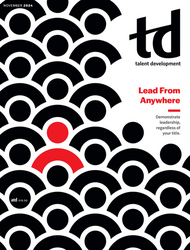TD Magazine Article
Workers Are Sticking Around
A focus on retention can reduce turnover rates.
Fri Nov 01 2024

US organizations' attrition rates are stabilizing, with more companies prioritizing retention in 2023. The 2024 US Organizational Wellbeing Report from Gallagher—an insurance, risk management, and consulting firm—found a majority of companies ranked retention as a top priority for HR and the second highest for operations (after growing revenue or sales).
Half of more than 3,500 responding US organizations experienced a turnover rate of 15 percent or higher. However, that's not an alarming number because two-thirds of employers experienced turnover either within or below their targeted range.
Those statistics have other implications. William F. Ziebell, benefits and HR consulting division CEO at Gallagher, says low attrition rates don't always translate to high levels of engagement and productivity.
"Employers should control what they can by continuously seeking opportunities to better align employee experiences with evolving generational expectations and offering benefits and programs that will entice their workforce to stay with the organization," explains Ziebell in a press release.
The report, part of Gallagher's Workforce Trends Report Series, notes that pay and benefits significantly influence attraction, retention, and competitive differentiation, but work culture remains one of the most important factors for prospective and current employees.
A 2022 Gallup report, Unleashing the Human Element at Work: Transforming Workplaces Through Recognition, found that creating a culture of recognition can save a 10,000-employee company up to $16.1 million in turnover costs annually.
"After base salary, work culture is the most prominent factor in hiring and retention success, so considering how to enliven this key aspect of the employee experience is vital," Gallup explains.
For instance, the Gallagher report indicates that communication practices make a difference. When more workers share their perspectives, it can be difficult for employers to promptly respond; but a delay in response or, worse, neglecting to do so can alienate staff. Therefore, companies can consider delivery methods for person-to-person connections—including when, where, how, and how often to message employees.

